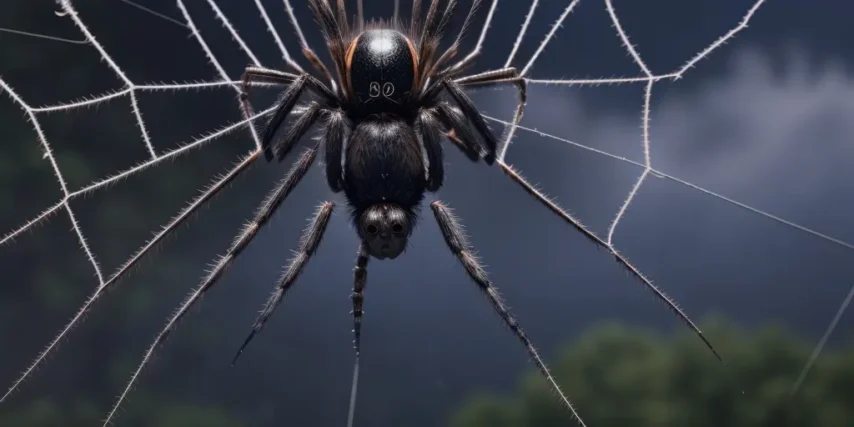The Intricate Artistry of Spider Webs: Unraveling the Mystery of Nature’s Master Weavers
In the intricate tapestry of the natural world, few creations captivate our imagination like the delicate and seemingly ethereal webs spun by spiders. These remarkable structures, both functional and artistic, serve as a testament to the ingenuity of nature’s architects. In this exploration, we delve into the mesmerizing world of spider silk, the fascinating process of web construction, and the evolutionary marvels that make spiders unparalleled weavers.
The Silk Secret:
At the heart of every spider’s web is its silk—a substance so remarkable that, pound for pound, it rivals the strength of steel. Produced by specialized glands called spinnerets located at the rear end of the spider’s abdomen, this silk is a complex proteinaceous fluid that transforms into solid threads upon contact with the air. The silk’s incredible tensile strength, lightness, and elasticity make it a versatile material with applications far beyond mere web construction.
Spider silk is a product of evolutionary refinement, adapted to suit the specific needs of each spider species. Orb-weaving spiders, for instance, produce different types of silk for various purposes within their webs, including dragline silk for the framework and sticky capture silk for ensnaring prey.

Web Architecture:
Spider webs come in a myriad of shapes and sizes, each adapted to the lifestyle and hunting strategy of the spider species. The classic orb web, resembling a wheel with radiating spokes, is a masterpiece of geometry and engineering. Constructed with meticulous precision, the orb web serves as both a residence and a trap for unsuspecting insects.
The process of web construction is an elaborate dance that varies among species but generally follows a similar sequence. The spider begins by releasing a silk thread into the air, allowing the wind to catch it and carry it to a suitable anchor point. Once anchored, the spider carefully traverses the distance, laying down the initial framework. This primary scaffolding provides the foundation for subsequent layers, intricately woven with spiral patterns to form the distinctive design of the orb web.
Adaptations in Web Design:
The diversity in web design reflects the adaptability of spiders to their environments and prey preferences. Take the funnel weavers, for example, who construct tubular webs that taper down to a retreat where the spider waits patiently for vibrations signaling potential prey. The sheet weavers, on the other hand, create horizontal sheets of silk to ambush passing insects, employing a stealthy strategy reminiscent of a trapdoor spider.
Noteworthy among web architects is the bolas spider, a master of deception. This ingenious creature swings a silk thread with a sticky silk-encrusted “bolas” at the end, mimicking the behavior of moths. When a male moth is lured by the apparent prospect of mating, the bolas spider strikes with precision, securing its meal.

Silk Varieties and Functions:
Spider silk is not a one-size-fits-all material; it comes in a range of types, each serving a specific purpose. Dragline silk, with its exceptional strength and elasticity, plays a crucial role in supporting the spider’s weight as it moves about its web. Capture silk, endowed with adhesive properties, ensures the effective entrapment of prey. Some spiders even produce silk for constructing egg sacs, providing a secure and protective environment for their offspring.
The miracle of spider silk lies in its versatility. Researchers are increasingly exploring its potential applications in various fields, from medicine to industry. The silk’s unique combination of strength and flexibility has inspired scientists to investigate its use in developing biodegradable fishing lines, lightweight body armor, and even artificial ligaments for medical purposes.

Evolutionary Marvels:
The ability to weave intricate webs is a product of millions of years of evolutionary refinement. Spiders have evolved specialized silk glands and spinnerets, enabling them to produce silk with varying properties to meet specific needs. This evolutionary arms race between spiders and their prey has led to a staggering diversity in web designs and silk types.
The process of web construction itself is a fascinating blend of instinct and learning. Young spiders often exhibit a degree of trial and error as they hone their web-building skills. Observing the architectural prowess of spiders reveals not just an innate ability but also a capacity to adapt and refine their techniques based on experience.
Conclusion:
The world of spider webs is a mesmerizing realm where artistry meets functionality. From the silk-spinning mechanisms within a spider’s abdomen to the intricate patterns of a completed web, each aspect of the process reflects the marvels of evolution and the relentless pursuit of survival. As we unravel the secrets of spider silk and explore the diverse designs of spider webs, we gain a deeper appreciation for the delicate yet robust beauty woven into the fabric of nature. As scientists continue to study these master weavers, we can only wonder what new insights and applications may emerge from the silent symphony of silk that spiders orchestrate in the hidden corners of our world.







